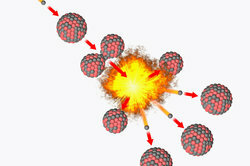What is the difference between the isotopes U235 and U238?
Can you really differentiate between the two uranium isotopes U235 and U238 and what is the difference? And what are isotopes anyway? These questions are dealt with here.

What you need:
- Basic knowledge of "nuclear physics"
How do isotopes differ?
- This term comes from the Nuclear physics, but it is also used in nuclear chemistry. Roughly speaking, isotopes are special varieties of one and the same chemical element. But how do they differ?
- An atom of a chemical element contains the atomic nucleus (with almost the entire mass) and the atomic shell (with the electrons). The atomic nucleus itself consists of two types of particles, namely the positively charged protons and the neutrons that carry no charge.
- The number of protons in the nucleus determines the atomic number of an element: Extreme examples are hydrogen with atomic number 1 (and a proton in the nucleus) and the element uranium, which you find in the Periodic table at position 92 - there are 92 protons in the nucleus.
- Depending on the element, the atomic nucleus contains slightly more neutrons. There are several varieties of almost all elements, i.e. isotopes, with different numbers of neutrons (stable and of course also unstable, i.e. radioactive).
- For example, hydrogen has two stable isotopes, namely normal hydrogen (with 1 proton) and the so-called. Deuterium (1 proton, 1 neutron). A third isotope, tritium, with 2 neutrons in the nucleus, is not stable.
- Chemically, the isotopes of an element behave in (almost) the same way, so that chemists do not have to worry about them. In nuclear physics, however, there can be differences between the individual isotopes of an element - for example with uranium.
What is an isotope in chemistry?
Isotopes are the "varieties" of the elements. Who is a little closer to the structure of the ...
U235 and U238 - two different uranium isotopes
- U235 and U238 are the two most important isotopes of the element uranium (there are others). The two atomic nuclei of the isotopes naturally have 92 protons, but in the first case 143 neutrons and in the second case 146 neutrons. This difference may not look very striking at first, but it also has an impact on the stability and decay of the two isotopes.
- The heavier isotope occurs to more than 99% in natural uranium, it is, so to speak, the main component. However, this isotope is not stable, but mainly decays through the release of an alpha particle in thorium (more precisely: Th-234), the natural uranium-radium series begins with this isotope. The half-life of this decay is around 5 billion. Years (so that U238 from the beginning of the earth is still present). A small proportion of the U238 cores split spontaneously. U238 is not suitable for building nuclear power plants as it cannot be split by capturing slow neutrons.
- The second most common isotope of uranium is U235, which also dates from the time the solar system was formed. However, it only has a share of less than 1%. The lighter uranium isotope is also not stable. It is also subject to alpha decay, but with a shorter half-life of around 700 million. Years. The natural uranium-actinium series begins with this isotope. This rare isotope is economically interesting because it is fissile (keyword: enrichment).
So what is the main difference between the two isotopes? First of all, in their mass, which is due to the different number of neutrons, their decay path and their time, as well as their economic importance as fissile material.
How helpful do you find this article?


